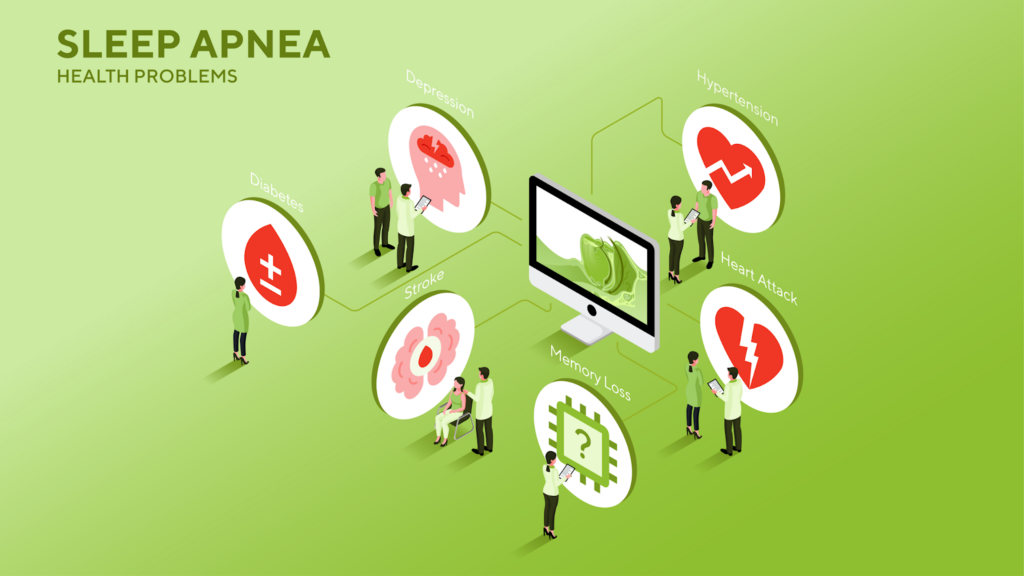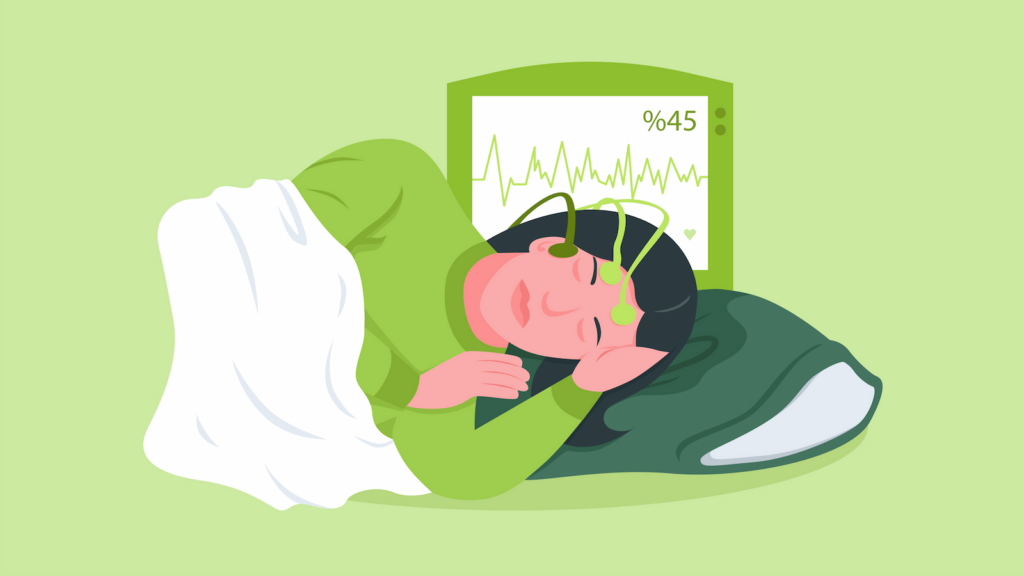Imagine a silent intruder lurking in the shadows of the night, disrupting the peace of your sleep yet so elusive that you remain unaware of its presence.
This is the reality for countless individuals grappling with Obstructive Sleep Apnea (OSA)—a prevalent yet often undiagnosed condition that stealthily undermines health and vitality.
The stakes are high. Left unchecked, OSA can strain the cardiovascular system and amplify the risk of hypertension, heart disease, and even type 2 diabetes.
But the impact extends beyond physical health.

Untreated OSA can lead to mood fluctuations and decreased productivity, casting a shadow over one’s quality of life.
This article serves as your beacon in the dark, guiding you through the intricacies of OSA.
From understanding its silent symptoms to the crucial role of the STOP-Bang questionnaire in early detection and diagnosis, we illuminate the path to better sleep health.
Let’s unravel the mystery of OSA together and step into a brighter, healthier future.
Understanding Obstructive Sleep Apnea (OSA)
Before diving into the STOP-Bang questionnaire, we’ll need to cover the basics of obstructive sleep apnea.
Obstructive Sleep Apnea (OSA) is more than just a disturbance to a good night’s sleep. It’s a prevalent yet frequently undiagnosed health concern.
Characterized by repeated blockages of the airway during sleep, OSA causes significant interruptions in breathing.
The Prevalence of Undiagnosed OSA
Research suggests that a substantial portion of the population, ranging from 10% to 20%, suffers from moderate to severe OSA without realizing it.
Symptoms like chronic snoring and excessive daytime sleepiness are often dismissed or overlooked, contributing to a high number of undiagnosed cases.
The Health Risks of Untreated OSA
Left unchecked, OSA can escalate into severe health complications.
It’s not just about disrupted sleep. OSA can strain the cardiovascular system, increasing the risk of hypertension and heart disease.

There’s also a demonstrated link between OSA and type 2 diabetes, attributed to the disorder’s impact on insulin resistance.
Beyond physical health, untreated OSA can lead to mood fluctuations and decreased productivity, significantly diminishing one’s quality of life.
Navigating Through OSA
Understanding and assessing the risk of OSA can be daunting for many.
Complex medical terminologies and the nuances of the condition can be overwhelming.
But that’s where guides like this step in to cut through the jargon and complex terminology and provide an accessible source of information that can inform your decisions and help you speak with your doctor about any medical concerns.
Diagnosing Obstructive Sleep Apnea
Obstructive Sleep Apnea (OSA) is typically diagnosed through an overnight study known as polysomnography.
Available in both in-home and lab-based variations, it’s the gold standard for diagnosing OSA and other sleep disorders.

However, whether using the in-home or lab-based option, you’re left to find a specialist to work with and talk to your doctor—often multiple times—to get things moving, and this isn’t always something accessible to everyone.
Challenges in Diagnosing OSA
Given these limitations, medical professionals have sought alternative diagnostic approaches.
The STOP-Bang Questionnaire has emerged as a prominent tool in this regard.
It offers a simple yet effective means of identifying individuals who might be suffering from OSA.
While it doesn’t replace polysomnographic testing, the STOP-Bang is a valuable preliminary screening tool.
This approach aids in distinguishing high-risk individuals for OSA, streamlining the process towards more definitive testing.
An Introduction to the STOP-Bang Questionnaire
Developed by anesthesiologists at Toronto Western Hospital, the STOP-Bang Questionnaire simplifies the early identification of OSA.
Its design focuses on both the symptoms and demographic factors associated with the condition.
The acronym “STOP-Bang” represents key OSA risk factors:
- Snoring
- Tiredness
- Observed apnea
- High blood pressure
- Body mass index
- Age
- Neck circumference
- Gender
The questionnaire’s mix of symptom-related and demographic questions comprehensively assesses an individual’s risk for OSA. Note that this means it cannot be used to diagnose sleep apnea.
Interpreting Your STOP-Bang Score and Its Usage in Medical Practice
The STOP-Bang Questionnaire’s scoring system is straightforward yet insightful, offering a quick assessment of one’s Obstructive Sleep Apnea (OSA) risk.
A score of three or more on the questionnaire signals a higher risk for moderate to severe OSA, guiding healthcare providers to consider further testing like polysomnography.
Understanding STOP-Bang Scores
The simplicity of scoring this questionnaire is one of its biggest benefits.
Each affirmative answer in the questionnaire contributes one point to the total score.
A score of 0 to 2 indicates a low risk for OSA, 3 to 4 suggests a moderate risk, and a score above five signals a high risk.
While highly sensitive, this system is not definitive and should be considered the first step in a multi-tiered diagnostic approach.
Further Assessments Based on STOP-Bang Scores
If your STOP-Bang score is consistently high, it shouldn’t be taken lightly.
Elevated scores are indicative of potential sleep disruptions that, if left untreated, could lead to serious health issues like heart disease or diabetes.

In such cases, healthcare providers often recommend further testing, such as polysomnography, to confirm the presence of OSA and gauge its severity.
Role of STOP-Bang in Medical Practice
In the clinical setting, the STOP-Bang questionnaire is a vital tool for early screening of OSA.
Its ease of use makes it particularly valuable in both general practice and specialized medical fields.
STOP-Bang in Surgical Contexts
The questionnaire is crucial in surgical contexts by assessing patients’ OSA risks preoperatively.
Those with high scores may require closer monitoring during and post-surgery due to increased risks related to anesthesia and postoperative complications.
Research highlights that undiagnosed or untreated OSA could lead to severe perioperative issues, emphasizing the importance of early detection through tools like STOP-Bang.
Importance of Early Detection and Treatment
Early identification and intervention in OSA are critical.
Timely treatment can prevent the condition’s progression and its associated health risks.
This proactive approach underscores the importance of tools like the STOP-Bang questionnaire in initiating early diagnostic pathways and facilitating timely management of OSA.
Reliability, Limitations, and Improvement of the STOP-Bang Questionnaire
While a highly effective tool in the initial detection of Obstructive Sleep Apnea (OSA), the STOP-Bang Questionnaire has certain limitations that affect its reliability.
Research Findings on STOP-Bang’s Effectiveness
Numerous independent studies have affirmed the questionnaire’s usefulness, with some showing very high success rates for identifying moderate to severe OSA.
However, as with all medical diagnostics—particularly survey-based options—there is always the risk of a false positive.
This necessitates a careful approach.
As such, medical professionals typically use STOP-Bang scores as part of a broader diagnostic process.
Factors Affecting STOP-Bang’s Accuracy
The accuracy of the questionnaire can vary depending on individual characteristics such as age, sex, and body mass index (BMI).
For example, men may score higher due to differences in snoring patterns and neck fat distribution.
Recognizing these variances, the medical community has adapted the questionnaire to ensure it is inclusive and relevant for different demographic groups.
Adapting and Refining the Questionnaire
To enhance its screening capabilities, the STOP-Bang Questionnaire has undergone adaptations to suit various groups.
Researchers have proposed alternative scoring methods and added questions related to lifestyle and medical history to improve its predictive accuracy.
These ongoing modifications ensure that the questionnaire remains a robust and evolving tool for OSA risk assessment.
The Pursuit of Continuous Improvement
The journey to perfect the STOP-Bang Questionnaire is ongoing.
New research findings constantly inform its refinement, maintaining its status as a crucial instrument in the early detection and management of OSA.
This commitment to improvement ensures that the STOP-Bang remains a relevant and reliable tool in various clinical settings.
Frequently Asked Questions about the STOP-Bang Questionnaire and Obstructive Sleep Apnea
What is Obstructive Sleep Apnea (OSA)?
At its simplest, obstructive sleep apnea is a sleep disorder where breathing repeatedly stops and starts during sleep due to blocked upper airways. You can learn more about the specifics in our guide.
How common is OSA?
OSA is quite common, with experts estimating that it affects about 10% to 20% of the adult population. However, experts also estimate that as many as 80 to 80% of OSA cases go undiagnosed due to a lack of information about the disorder or lack of access to medical care and diagnostics.
Can OSA lead to other health problems?
Yes, if left untreated, OSA can lead to serious health issues such as hypertension, heart disease, type 2 diabetes, and mood disorders.
How is OSA diagnosed?
OSA is typically diagnosed through a sleep study known as polysomnography, which monitors sleep, breathing, and other body functions during an overnight stay at a sleep center.
At-home versions of this test are also available to provide a diagnosis with reduced discomfort and inconvenience. However, they are only approved for use in some regions.
Is OSA only a concern for older adults?
While OSA is more common in older adults, it can affect people of any age, including children, especially those with risk factors like obesity or enlarged tonsils.
What is the STOP-Bang Questionnaire?
The STOP-Bang Questionnaire is a simple screening tool developed to identify individuals at risk of having OSA.
It assesses symptoms and risk factors like snoring, tiredness, observed apnea, high blood pressure, BMI, age, neck circumference, and gender.
What is the success rate of the STOP-Bang Questionnaire in predicting OSA compared to traditional sleep studies?
The STOP-Bang Questionnaire is a highly effective initial screening tool with a good predictive value, especially for identifying moderate to severe OSA.
However, it does not replace polysomnography (sleep studies)—the definitive method for diagnosing OSA.
The questionnaire is best used to determine if a sleep study is warranted.
Can the STOP-Bang Questionnaire be used for pediatric patients, or is it only suitable for adults?
The STOP-Bang Questionnaire is validated for use in adults. Pediatric OSA often has different risk factors and presentations, so specific pediatric assessment tools are used for children.
For more information, check out our guide on how sleep apnea affects children.
How often should someone retake the STOP-Bang Questionnaire to monitor for OSA?
There is no fixed schedule for retaking the questionnaire.
It should be retaken if symptoms worsen, significant changes in weight or neck circumference, or related health conditions develop.
If I have a high STOP-Bang score, what is the next step in getting a formal diagnosis?
A high STOP-Bang score indicates a higher risk for OSA.
The next step would be to consult a healthcare provider, such as your family doctor, who may recommend a sleep study for a formal diagnosis.
How can I access the STOP-Bang Questionnaire, and do I need a healthcare provider to administer it?
The STOP-Bang Questionnaire can often be found online or provided by a healthcare provider.
It is designed to be simple and can be self-administered. However, discussing the results with a healthcare provider is crucial for appropriate follow-up.
What should I do if I suspect I have OSA but have a low STOP-Bang score?
If you suspect you have OSA but have a low score on the STOP-Bang, it’s essential to consult with a healthcare provider.
They can conduct a thorough evaluation and decide if further testing is necessary, taking into account other symptoms and risk factors not captured by the questionnaire.
Conclusion
The STOP-Bang Questionnaire is critical in understanding and managing obstructive sleep apnea.
It’s a simple yet effective tool that assists physicians in identifying potential OSA cases early on.
While it has its limitations, ongoing research and adaptations continue to enhance its accuracy and applicability.
For individuals and healthcare providers alike, understanding and using the STOP-Bang Questionnaire is a significant step toward effectively managing sleep apnea.
For those diagnosed with OSA, CPAP Supply offers a comprehensive range of CPAP machines and accessories, combining quality and affordability.
Our commitment to customer satisfaction ensures that every client receives personalized care and the best solutions for their sleep apnea therapy needs.
Embrace a healthier lifestyle with the right CPAP equipment from CPAP Supply, Canada’s leading online CPAP store.
References:
- MD+CALC: STOP-Bang Score for Obstructive Sleep Apnea
- STOP-Bang: STOP-Bang Questionaire
- Sleep Foundation: STOP-Bang Score for Obstructive Sleep Apnea
- OSMI: STOP-Bang Sleep Apnea Questionaire[PDF]
- UpToDate: Calculator: Enhanced STOP-Bang Screening for Obstructive Sleep Apnea
- SleepApnea.org: STOP-Bang Score for Obstructive Sleep Apnea
- Sleepeducation.org: STOP-Bang Questionaire[PDF]
- Sleep Doctor: STOP-Bang Score for Sleep Apnea
- NIH: Exploring the STOP-Bang Questionaire for Obstructive Sleep Apnea Screening in Seniors
- NIH: Use and Performance of the STOP-Bang Questionaire for Obstructive Sleep Apnea Screening Across Geographic Regions
- NIH: The STOP-Bang Test is Useful for Predicting the Severity of Obstructive Sleep Apnea
- MDApp: STOP-Bang Questionaire
- ATS: Sleep-Related Questionnaires
- AAFP: Obstructive Sleep Apnea and Chronic Insomnia Disorder Updated Guidelines from the Va/DoD
- NIH: An Update on the Various Practical Applications of the STOP-Bang Questionaire in Anesthesia, Surgery, Perioperative Medicine
- BMC Anesthesiology: Validation of the STOP-Bang questionnaire as a preoperative screening tool for obstructive sleep apnea: a systematic review and meta-analysis

